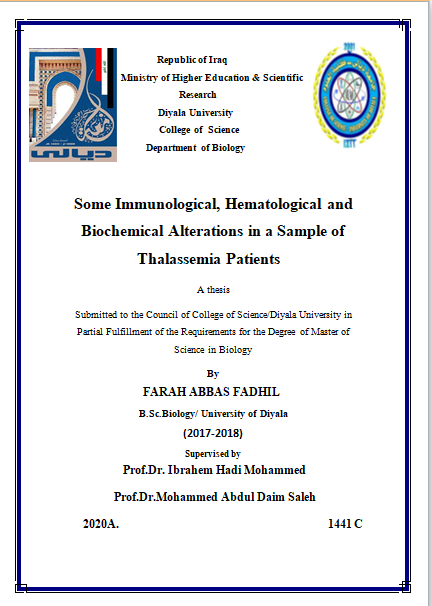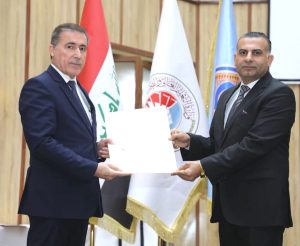summary
The present study aimed to evaluate the immune role of human leukocyte antigens HLA-G and some vital indicators in patients with thalassemia B patients. This study was conducted at the Center for Hematology / Thalassemia – Diyala Governorate, which continued from the beginning of October 2019 to the end of February 2020, which included assessing the immune status of chronic thalassemia patients by measuring HLA-G and some immunological indicators as well as evaluating a number of indicators Bloody and biochemical. Immunohistochemistry indicators included the measurement of the level of human leukocyte antigens HLA-G, the measurement of levels of immunological markers CD4 & CD8 and the measurement of IL-17A white levels by means of the enzyme-linked immunosorbent assay (ELISA)
Hematological indicators included: RBC, HGB, HCT, MCV, MCH, and MCHC. Leukocytes WBC, NEU, LYM, MON. and PLT. As for the measured indicators, hormones included T4, T3, TSH, LH, and FSH. As for the measurement of liver function, it included ALT, AST, ALP. Biochemical indicators included Ferritin and Creatinin. This study included 90 samples, of which 60 samples belong to patients with thalassemia patients 30 males and 30 females, with age rang span ranging from (1 to27 ) years, and 30 samples collected from healthy people 15 males and 15 females within the age range between (15 to 30) years ago, they were used as a control group, in addition to that, samples of chronic thalassemia patients were collected after being diagnosed by a doctor specializing in the Center for Hematology / Thalassemia – Diyala Governorate.
The results of the current study indicated a significant difference at a probability level of (P <0.05), and a high level of HLA-G was recorded in patients ng / ml 91.607 compared to the control group ng / ml 87.278. The percentage of males in females was higher than females and reached 101.087 ng / ml 82.027, respectively. As for age groups, its percentage was in the age group (27-19) years and reached ng / ml 106.242 higher than age groups (1-9), (10-18) years and reached ng / ml 85.126 ng / ml, 78.573 respectively
The results of the current study showed the presence of a highly significant difference at the probability level (P < 0.01), and a high CD8 level was recorded among patients and it reached 154.598 ng / ml compared to the control group and it reached 136.083 ng / ml. While the percentage of females was equal to that of males and reached 154.937 ng / ml, ng / ml, respectively. As for age groups, its percentage was in the age group (10-18) years and it reached ng / ml 162.638 higher than the age groups (27-19), (9-1) years and it reached ng / ml 151.289 ng / ml, 150.972, respectively
The results of the current study showed that there was no significant difference at a probability level of (P <0.05), and a high CD4 level was recorded in patients ng / ml 216.991 compared to the control group ng / ml 199.192. While the percentage of females is higher than that of males, it reached 219.157 ng / ml, 214.824, respectively. For age groups, its proportion was in the age group (1-9) years and it reached 236.725 ng / ml higher than the age groups ( 27-19), and (10-18) years, and it reached 211.432 ng / ml 206.359 ng / ml, respectively
The results of the current study showed a high significant difference at the probability level (P <0.01), and between the high level of IL-17A in patients ng / ml 64.400 compared to the control group ng / ml 43.164. While the percentage of males is higher than that of females, and it reached 66.552ng / ml ng / ml, 62.247, respectively. As for the age groups, its percentage was in the age group 1018-year, and the ng / ml was 77.801 higher than the age groups (1-9), (19-27) years The ng / ml was 66.254 ng / ml, 52.958, respectively
The results of the current study indicated a comparison between the level of thalassemia and healthy subjects in the white blood cells markers WBC, LYM, MON, as they were higher in thalassemia patients compared with healthy ones. While the level of NEU as it was lower in patients with thalassemia compared with healthy ones. On the other hand, it showed that the level of indicators of erythrocytes RBC, HGB, HCT, MCV, and MCH are lower in thalassemia patients compared with healthy ones. While the level of MCHC as it was higher in patients with thalassemia compared with the healthy ones, on the other hand, it indicated that the level of platelet indicators, PLT, and MPV as it was higher in patients with thalassemia compared with the healthy ones, with a high significant difference and at the probability level (P <0.01)
The results of the current study indicated a comparison between the level of thalassemia and healthy subjects in the indicators of thyroid hormones T3 and TSH, as they were higher in thalassemia patients compared with healthy ones. While the level of T4 as it was lower in patients with thalassemia compared to healthy subjects, the presence of a highly significant difference at the probability level (P <0.01)
On the other hand, the results of the current study indicated a comparison between the level of thalassemia and healthy subjects in the indicators of sexual hormones LH, FSH, as they were less in thalassemia patients compared with healthy ones, with a high significant difference and at the probability level (P <0.01)
The results of the current study indicated a comparison between the level of thalassemia and healthy subjects in the indicators for liver functions ALT, ATP, and AST, as it was higher in thalassemia patients compared to healthy ones. On the other hand, it indicated that the level of iron-chemical indicators is higher in patients with thalassemia compared to healthy people, while creatinin level is lower in Thalassemia patients was compared to healthy subjects, with a highly significant difference (P <0.01)




